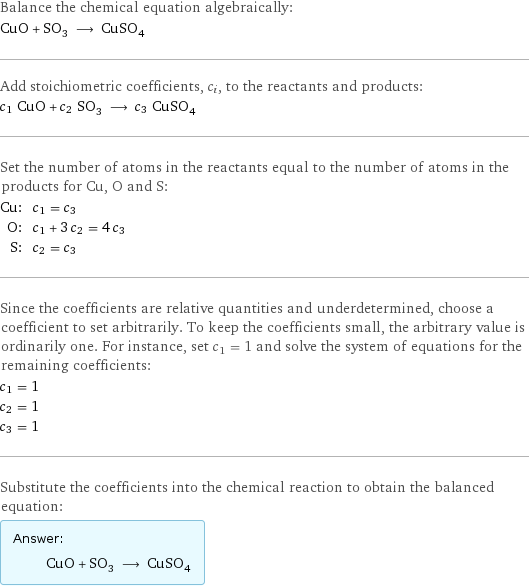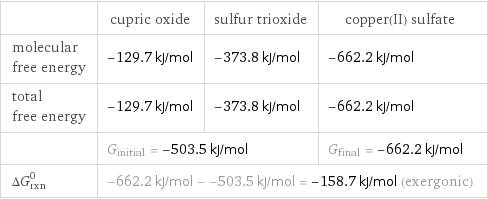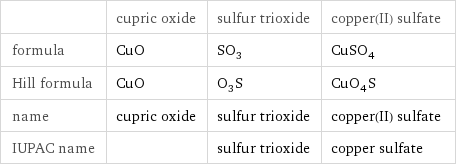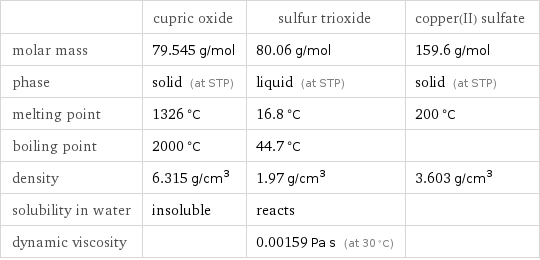Input interpretation

CuO cupric oxide + SO_3 sulfur trioxide ⟶ CuSO_4 copper(II) sulfate
Balanced equation

Balance the chemical equation algebraically: CuO + SO_3 ⟶ CuSO_4 Add stoichiometric coefficients, c_i, to the reactants and products: c_1 CuO + c_2 SO_3 ⟶ c_3 CuSO_4 Set the number of atoms in the reactants equal to the number of atoms in the products for Cu, O and S: Cu: | c_1 = c_3 O: | c_1 + 3 c_2 = 4 c_3 S: | c_2 = c_3 Since the coefficients are relative quantities and underdetermined, choose a coefficient to set arbitrarily. To keep the coefficients small, the arbitrary value is ordinarily one. For instance, set c_1 = 1 and solve the system of equations for the remaining coefficients: c_1 = 1 c_2 = 1 c_3 = 1 Substitute the coefficients into the chemical reaction to obtain the balanced equation: Answer: | | CuO + SO_3 ⟶ CuSO_4
Structures

+ ⟶
Names

cupric oxide + sulfur trioxide ⟶ copper(II) sulfate
Reaction thermodynamics
Gibbs free energy

| cupric oxide | sulfur trioxide | copper(II) sulfate molecular free energy | -129.7 kJ/mol | -373.8 kJ/mol | -662.2 kJ/mol total free energy | -129.7 kJ/mol | -373.8 kJ/mol | -662.2 kJ/mol | G_initial = -503.5 kJ/mol | | G_final = -662.2 kJ/mol ΔG_rxn^0 | -662.2 kJ/mol - -503.5 kJ/mol = -158.7 kJ/mol (exergonic) | |
Equilibrium constant
![Construct the equilibrium constant, K, expression for: CuO + SO_3 ⟶ CuSO_4 Plan: • Balance the chemical equation. • Determine the stoichiometric numbers. • Assemble the activity expression for each chemical species. • Use the activity expressions to build the equilibrium constant expression. Write the balanced chemical equation: CuO + SO_3 ⟶ CuSO_4 Assign stoichiometric numbers, ν_i, using the stoichiometric coefficients, c_i, from the balanced chemical equation in the following manner: ν_i = -c_i for reactants and ν_i = c_i for products: chemical species | c_i | ν_i CuO | 1 | -1 SO_3 | 1 | -1 CuSO_4 | 1 | 1 Assemble the activity expressions accounting for the state of matter and ν_i: chemical species | c_i | ν_i | activity expression CuO | 1 | -1 | ([CuO])^(-1) SO_3 | 1 | -1 | ([SO3])^(-1) CuSO_4 | 1 | 1 | [CuSO4] The equilibrium constant symbol in the concentration basis is: K_c Mulitply the activity expressions to arrive at the K_c expression: Answer: | | K_c = ([CuO])^(-1) ([SO3])^(-1) [CuSO4] = ([CuSO4])/([CuO] [SO3])](../image_source/02b7a70f66368b6946a3d87f8d97ae57.png)
Construct the equilibrium constant, K, expression for: CuO + SO_3 ⟶ CuSO_4 Plan: • Balance the chemical equation. • Determine the stoichiometric numbers. • Assemble the activity expression for each chemical species. • Use the activity expressions to build the equilibrium constant expression. Write the balanced chemical equation: CuO + SO_3 ⟶ CuSO_4 Assign stoichiometric numbers, ν_i, using the stoichiometric coefficients, c_i, from the balanced chemical equation in the following manner: ν_i = -c_i for reactants and ν_i = c_i for products: chemical species | c_i | ν_i CuO | 1 | -1 SO_3 | 1 | -1 CuSO_4 | 1 | 1 Assemble the activity expressions accounting for the state of matter and ν_i: chemical species | c_i | ν_i | activity expression CuO | 1 | -1 | ([CuO])^(-1) SO_3 | 1 | -1 | ([SO3])^(-1) CuSO_4 | 1 | 1 | [CuSO4] The equilibrium constant symbol in the concentration basis is: K_c Mulitply the activity expressions to arrive at the K_c expression: Answer: | | K_c = ([CuO])^(-1) ([SO3])^(-1) [CuSO4] = ([CuSO4])/([CuO] [SO3])
Rate of reaction
![Construct the rate of reaction expression for: CuO + SO_3 ⟶ CuSO_4 Plan: • Balance the chemical equation. • Determine the stoichiometric numbers. • Assemble the rate term for each chemical species. • Write the rate of reaction expression. Write the balanced chemical equation: CuO + SO_3 ⟶ CuSO_4 Assign stoichiometric numbers, ν_i, using the stoichiometric coefficients, c_i, from the balanced chemical equation in the following manner: ν_i = -c_i for reactants and ν_i = c_i for products: chemical species | c_i | ν_i CuO | 1 | -1 SO_3 | 1 | -1 CuSO_4 | 1 | 1 The rate term for each chemical species, B_i, is 1/ν_i(Δ[B_i])/(Δt) where [B_i] is the amount concentration and t is time: chemical species | c_i | ν_i | rate term CuO | 1 | -1 | -(Δ[CuO])/(Δt) SO_3 | 1 | -1 | -(Δ[SO3])/(Δt) CuSO_4 | 1 | 1 | (Δ[CuSO4])/(Δt) (for infinitesimal rate of change, replace Δ with d) Set the rate terms equal to each other to arrive at the rate expression: Answer: | | rate = -(Δ[CuO])/(Δt) = -(Δ[SO3])/(Δt) = (Δ[CuSO4])/(Δt) (assuming constant volume and no accumulation of intermediates or side products)](../image_source/63b471a3286466e86f9b8e40bd7d8063.png)
Construct the rate of reaction expression for: CuO + SO_3 ⟶ CuSO_4 Plan: • Balance the chemical equation. • Determine the stoichiometric numbers. • Assemble the rate term for each chemical species. • Write the rate of reaction expression. Write the balanced chemical equation: CuO + SO_3 ⟶ CuSO_4 Assign stoichiometric numbers, ν_i, using the stoichiometric coefficients, c_i, from the balanced chemical equation in the following manner: ν_i = -c_i for reactants and ν_i = c_i for products: chemical species | c_i | ν_i CuO | 1 | -1 SO_3 | 1 | -1 CuSO_4 | 1 | 1 The rate term for each chemical species, B_i, is 1/ν_i(Δ[B_i])/(Δt) where [B_i] is the amount concentration and t is time: chemical species | c_i | ν_i | rate term CuO | 1 | -1 | -(Δ[CuO])/(Δt) SO_3 | 1 | -1 | -(Δ[SO3])/(Δt) CuSO_4 | 1 | 1 | (Δ[CuSO4])/(Δt) (for infinitesimal rate of change, replace Δ with d) Set the rate terms equal to each other to arrive at the rate expression: Answer: | | rate = -(Δ[CuO])/(Δt) = -(Δ[SO3])/(Δt) = (Δ[CuSO4])/(Δt) (assuming constant volume and no accumulation of intermediates or side products)
Chemical names and formulas

| cupric oxide | sulfur trioxide | copper(II) sulfate formula | CuO | SO_3 | CuSO_4 Hill formula | CuO | O_3S | CuO_4S name | cupric oxide | sulfur trioxide | copper(II) sulfate IUPAC name | | sulfur trioxide | copper sulfate
Substance properties

| cupric oxide | sulfur trioxide | copper(II) sulfate molar mass | 79.545 g/mol | 80.06 g/mol | 159.6 g/mol phase | solid (at STP) | liquid (at STP) | solid (at STP) melting point | 1326 °C | 16.8 °C | 200 °C boiling point | 2000 °C | 44.7 °C | density | 6.315 g/cm^3 | 1.97 g/cm^3 | 3.603 g/cm^3 solubility in water | insoluble | reacts | dynamic viscosity | | 0.00159 Pa s (at 30 °C) |
Units
